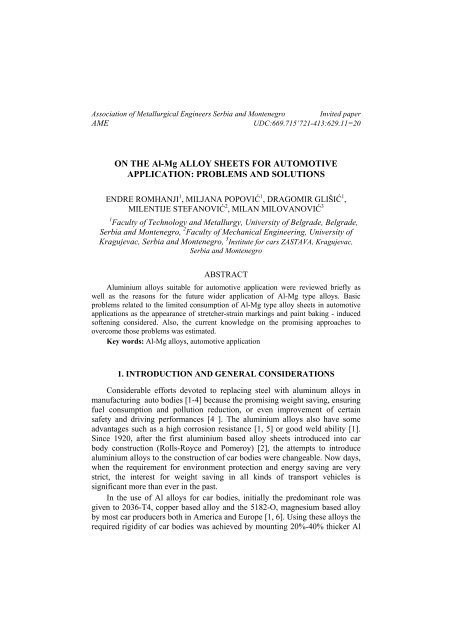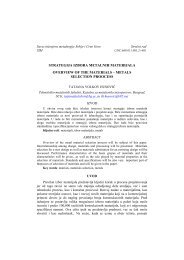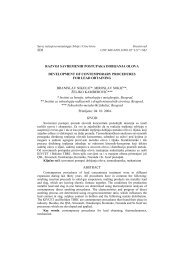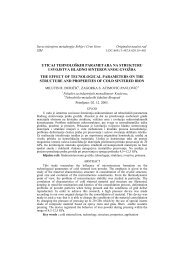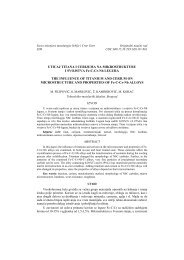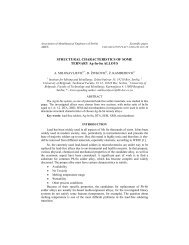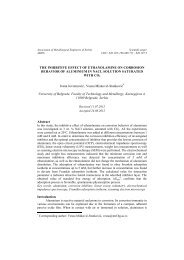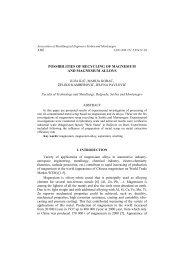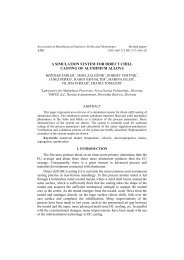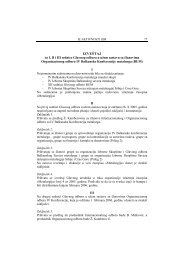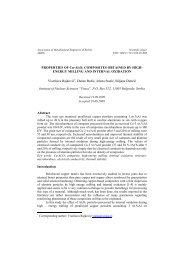ON THE Al-Mg ALLOY SHEETS FOR AUTOMOTIVE APPLICATION ...
ON THE Al-Mg ALLOY SHEETS FOR AUTOMOTIVE APPLICATION ...
ON THE Al-Mg ALLOY SHEETS FOR AUTOMOTIVE APPLICATION ...
Create successful ePaper yourself
Turn your PDF publications into a flip-book with our unique Google optimized e-Paper software.
Association of Metallurgical Engineers Serbia and Montenegro Invited paper<br />
AME<br />
UDC:669.715’721-413:629.11=20<br />
<strong>ON</strong> <strong>THE</strong> <strong>Al</strong>-<strong>Mg</strong> <strong>ALLOY</strong> <strong>SHEETS</strong> <strong>FOR</strong> <strong>AUTOMOTIVE</strong><br />
APPLICATI<strong>ON</strong>: PROBLEMS AND SOLUTI<strong>ON</strong>S<br />
ENDRE ROMHANJI 1 , MILJANA POPOVIĆ 1 , DRAGOMIR GLIŠIĆ 1 ,<br />
MILENTIJE STEFANOVIĆ 2 , MILAN MILOVANOVIĆ 3<br />
1 Faculty of Technology and Metallurgy, University of Belgrade, Belgrade,<br />
Serbia and Montenegro, 2 Faculty of Mechanical Engineering, University of<br />
Kragujevac, Serbia and Montenegro, 3 Institute for cars ZASTAVA, Kragujevac,<br />
Serbia and Montenegro<br />
ABSTRACT<br />
<strong>Al</strong>uminium alloys suitable for automotive application were reviewed briefly as<br />
well as the reasons for the future wider application of <strong>Al</strong>-<strong>Mg</strong> type alloys. Basic<br />
problems related to the limited consumption of <strong>Al</strong>-<strong>Mg</strong> type alloy sheets in automotive<br />
applications as the appearance of stretcher-strain markings and paint baking - induced<br />
softening considered. <strong>Al</strong>so, the current knowledge on the promising approaches to<br />
overcome those problems was estimated.<br />
Key words: <strong>Al</strong>-<strong>Mg</strong> alloys, automotive application<br />
1. INTRODUCTI<strong>ON</strong> AND GENERAL C<strong>ON</strong>SIDERATI<strong>ON</strong>S<br />
Considerable efforts devoted to replacing steel with aluminum alloys in<br />
manufacturing auto bodies [1-4] because the promising weight saving, ensuring<br />
fuel consumption and pollution reduction, or even improvement of certain<br />
safety and driving performances [4 ]. The aluminium alloys also have some<br />
advantages such as a high corrosion resistance [1, 5] or good weld ability [1].<br />
Since 1920, after the first aluminium based alloy sheets introduced into car<br />
body construction (Rolls-Royce and Pomeroy) [2], the attempts to introduce<br />
aluminium alloys to the construction of car bodies were changeable. Now days,<br />
when the requirement for environment protection and energy saving are very<br />
strict, the interest for weight saving in all kinds of transport vehicles is<br />
significant more than ever in the past.<br />
In the use of <strong>Al</strong> alloys for car bodies, initially the predominant role was<br />
given to 2036-T4, copper based alloy and the 5182-O, magnesium based alloy<br />
by most car producers both in America and Europe [1, 6]. Using these alloys the<br />
required rigidity of car bodies was achieved by mounting 20%-40% thicker <strong>Al</strong>
206<br />
MJoM<br />
METALURGIJA - JOURNAL OF METALLURGY<br />
sheets in respect to the usual mild steel sheets. The 2036 alloy is heat – treatable<br />
(hardenable by aging) and it was used for outer body parts, while 5182 sheets<br />
due to their particular surface relief developed during Lüdering (due dynamic<br />
strain aging) were rather suitable for inner body elements. The 5182 alloy is<br />
non-heat-treatable, and hardenable by the <strong>Mg</strong> solute as well as by deformation.<br />
The two alloys have a quite different response during curing the painted car<br />
bodies. So, during paint baking the 2036 alloy at around 180°C considerable<br />
strengthening effects can be achieved due the precipitation hardening. At the<br />
same conditions the strength of <strong>Al</strong>-<strong>Mg</strong> alloys in a similar extent decrease after a<br />
5-7% pre-deformation. Further, it was recognized that the combination of these<br />
two alloys is unfavorable as far as recycling is concerned, due to the relatively<br />
high copper content in 2036 alloy. Searching for the alloy more compatible in<br />
recycling with 5000 type, the <strong>Al</strong><strong>Mg</strong>Si alloys (6000-heat-tretable series) were<br />
chosen. The basic response of 5000 and 6000 alloy sheets in paint baking is<br />
shown in Fig.1. It is obvious that after annealing at 200°C/30' the heat-treatable<br />
6009 alloy considerably hardened (the precipitation sequence is quite<br />
complicating [7]), while the 5182 one in a similar extent softens. The most<br />
frequently used alloys today and their chemical compositions are listed in Table<br />
1. Summary of the main characteristics and applications for the aluminium<br />
alloys used in car body constructions are given in Table 2. Some recent<br />
analyses [8] shown up a recommendation that the further automotive application<br />
of aluminium should be focused to the development of low cost, non-heattreatable<br />
aluminium alloy body sheets. Namely, it was estimated that there is<br />
potential for at least 10% lower costs for the non-heat-treatable alloys compared<br />
to the heat-treatable types. Such a considerations make attractive the further<br />
research and improvement of the highly alloyed and high strength <strong>Al</strong>-<strong>Mg</strong><br />
sheets. So, the objective of this work is comprehensive consideration of the<br />
basic deformation behavior of <strong>Al</strong>-<strong>Mg</strong> alloy sheets, current applicability<br />
restrictions and possible solutions for overcoming them.<br />
Table 1. Compositions of some aluminium alloys used for automotive panel<br />
applications (wt.%) [9]<br />
<strong>Al</strong>loy Si Fe Cu Mn <strong>Mg</strong> Cr Zn Ti<br />
5182-O 0.20 0.35 0.15 0.2-0.5 4.0-5.0 0.10 0.25 0.10<br />
5754-O 0.40 0.40 0.10 0.50 2.6-3.6 0.3 0.2 0.15<br />
5030-T4 0.25 0.40 0.50 0.20 3.5-5.0 0.2 0.1 0.10<br />
2036-T4 0.50 0.50 2.2-3.0 0.1-0.4 0.3-0.6 0.10 0.25 0.15<br />
6009-T4 0.6-1.0 0.50 0.15-0.60 0.2-0.8 0.4-0.8 0.10 0.25 0.10<br />
6010-T4 0.8-1.2 0.50 0.15-0.60 0.2-0.8 0.6-1.0 0.10 0.25 0.1<br />
6016-T4<br />
(Ac-120)<br />
1.0-1.5 0.5 0.2 0.2 0.25-0.6 0.1 0.2 0.15
<strong>ON</strong> <strong>THE</strong> <strong>Al</strong>-<strong>Mg</strong> <strong>ALLOY</strong> <strong>SHEETS</strong> <strong>FOR</strong> <strong>AUTOMOTIVE</strong> APPLICATI<strong>ON</strong> … 207<br />
Table 2. <strong>Al</strong>uminium car body sheet alloys [10]<br />
<strong>Al</strong>-<strong>Mg</strong><br />
AA5xxx<br />
<strong>Al</strong>-<strong>Mg</strong>-Cu<br />
AA5xxx<br />
<strong>Al</strong>-<strong>Mg</strong>-Si<br />
AA6xxx<br />
<strong>Al</strong>loy Advantages Disadvantages Examples<br />
<strong>Al</strong>-<strong>Mg</strong>-Si-Cu<br />
AA6xxx<br />
<strong>Al</strong>-Cu-<strong>Mg</strong>-Si<br />
AA2xxx<br />
- high formability<br />
- good corrosion resistance<br />
- medium to high strength<br />
- as above but also<br />
additional age hardening<br />
- high formability<br />
- good corrosion resistance<br />
- strengthening by aging<br />
- as above but higher<br />
strength<br />
- high formability<br />
- strengthening by aging<br />
- Lüders lines, "A" and "B"<br />
- SCC sensitive after<br />
exposure to temp. ∼ 100°C<br />
- softening after annealing<br />
- as above, but only "B"<br />
Lüders lines<br />
- as above but<br />
decreased corrosion<br />
resistance<br />
- decreased corrosion<br />
resistance<br />
-<br />
AA5754, AA5182<br />
for inner body parts<br />
AA5030, AA5032<br />
for outer body parts<br />
in Japan<br />
AA6016, AA6022<br />
standard alloy for<br />
outer body parts<br />
AA6009, AA6111<br />
outer/inner body<br />
AA2008, AA2036<br />
only used in USA<br />
Fig. 1. Effect of stretching and aging (30' at 204°C) on yield<br />
strength of 5182-O and 6009-T4 alloy sheets [6].<br />
2. <strong>Al</strong>-<strong>Mg</strong> <strong>ALLOY</strong> <strong>SHEETS</strong> <strong>FOR</strong> <strong>AUTOMOTIVE</strong> APPLICATI<strong>ON</strong><br />
The <strong>Al</strong>-<strong>Mg</strong> alloys have a favorable formability, as due solution hardening<br />
they can achieve high strength and high strain hardening ability, which enable a<br />
stable behavior in the complex forming operation, reducing the further material<br />
flow in the locally strained regions [11,12]. Such behavior is improved in alloys<br />
with higher <strong>Mg</strong> content. Besides the favorable forming behavior, the present<br />
solute atoms can induce some harmful surface appearance of produced auto<br />
body parts.
208<br />
MJoM<br />
METALURGIJA - JOURNAL OF METALLURGY<br />
Surface appearance. In <strong>Al</strong>-<strong>Mg</strong> alloys the dislocation reactions with solute<br />
<strong>Mg</strong> atoms, i.e. the dynamic strain aging (DSA), is the main source of unstable<br />
plastic flow during the uniaxial tension test. This unstable flow in alloys with<br />
more than 2% magnesium [7] appeared as a yield point elongation, know as a<br />
Lüders elongation. This inhomogeneous deformation occurs within the first few<br />
percent of straining when the stress is constant. After that – at higher strains, the<br />
DSA is manifested as a discontinuous or serrated yielding. Flow curves for a<br />
highly alloyed <strong>Al</strong><strong>Mg</strong>6.5Mn alloy sheet, after different treatment and strain rates<br />
are shown in Fig.2. The Lüders elongation plateaus and serrations or<br />
discontinuous yielding ranges are very clear. Both Lüdering and serrated yielding<br />
during uniaxial stretching cause the appearance of specific surface relief known as<br />
"A" ("flamboyant") and "B" ("parallel bands") type surface markings, respectively.<br />
Those markings and the appropriate parts of the flow curves are sown in Fig.3. The<br />
"A" stretcher markings are the most harmful as the appropriate roughness valleys<br />
developed within the first percent of straining can be more than 100 μm deep [14].<br />
The roughness created by "B" marking never exceeds 10 μm [15]. So, the "A" type<br />
stretcher markings are the main problem which reduces the application of a higher<br />
strength (highly alloyed) <strong>Al</strong>-<strong>Mg</strong> sheets only to the production of inner panels in car<br />
bodies<br />
Fig. 2. Load extension curves for the <strong>Al</strong><strong>Mg</strong>6.5Mn sheets at different<br />
strain rates and working conditions. [13]<br />
During biaxial stretching the surface appearance seems to change<br />
dependently on the degree of biaxiality. Namely, after stretching blanks of<br />
different widths across the hemispherical punch in a hydraulic press a net of<br />
parallel bands can be seen at the surface of the nearly uniaxially stretched<br />
samples which are “B” type (Fig. 4.a) without any traces of “A” type. The<br />
surface banding completely disappeared in the case of equibiaxially stretched<br />
sample (Fig.4.b). It is important to note that in the samples even nearly<br />
uniaxially stretched over the punch, the very harmful “A” type (“flamboyant”<br />
type) surface markings could not be observed. The latest result (Fig.4) indicates
<strong>ON</strong> <strong>THE</strong> <strong>Al</strong>-<strong>Mg</strong> <strong>ALLOY</strong> <strong>SHEETS</strong> <strong>FOR</strong> <strong>AUTOMOTIVE</strong> APPLICATI<strong>ON</strong> … 209<br />
that the surface appearance can be influenced in a great deal by changing the<br />
stress state, and that the harmful stretcher lines disappear in equibiaxial<br />
stretching. At this stage of the knowledge it is not clear how the stress state<br />
influence the DSA, inhibiting the appearance of the surface relief development<br />
under equibiaxial stretching. The meaning of the considered surface relief<br />
effects are clearly shown in Fig.5 at the photographs of real fender produced<br />
from <strong>Al</strong><strong>Mg</strong>4.5Mn0, 5 sheets, for the "ZASTAVA" car. The stretcher-strain lines<br />
developed are not uniform over the whole fender, but it seems dependent on the<br />
imposed stress state (the biaxiality varying over the fender during the pressing<br />
operation).<br />
Fig. 3. Uniaxial stress-strain curves with Lüders elongation<br />
(a) or only with serrated yielding straining range<br />
(b) and the sketches of appropriate surface markings.<br />
a) b)<br />
Fig. 4. Photographs and sketches for the samples stretched over<br />
hemispherical punch in near uniaxial (a) and equibiaxial tension (b) [16].
210<br />
MJoM<br />
METALURGIJA - JOURNAL OF METALLURGY<br />
Considering the problem how to suppress the Lüders elongation it is worth<br />
of note that applying some specific thermo-mechanical treatments as a<br />
combination of low cold rolling reductions and annealing (Fig.2), the Lüders<br />
elongation was completely suppressed. The grain size distributions for the<br />
applied working conditions are given in Table 3.<br />
x7 x 15<br />
Fig. 5. Photographs of the surface appearance at the fender made<br />
of AA5182 alloy sheet. [17]<br />
Table 3. Average grain diameters after different reductions and annealing at<br />
320°C/3h. [13]<br />
r (%) d av (μm) r (%) d av (μm)<br />
0 30.9 30 30.4<br />
5 35.1 40 23.2<br />
10 38.4 50 21.8<br />
15 40.5 60 20.6<br />
20 35.4 70 16.1<br />
Micrographs revealing the structures for the samples with no yield point<br />
elongation – after 10% deformation and with pronounced yield point elongation<br />
after 60% deformation are shown in Fig.6. The grain structure after 10%<br />
imposed reduction and annealing (Fig.6a), is a result of additional grain growth<br />
in the basic structure retained from the as received-annealed condition. <strong>Al</strong>so<br />
subgrains were generated by such a low deformation (Fig.6b). Besides the<br />
additional hardening brought by the presence of 1.0-1.5 μm sized subgrains [13]<br />
it was assumed that the higher dislocation density with weaker solute drag, as<br />
the <strong>Mg</strong> atmospheres become more dilute, is the main reason for vanishing the<br />
yield point elongation. It should be emphasized that grain sizes after those low<br />
reductions and annealing where ranged to 35÷40μm (Table 3), what is rather<br />
close to the grain sizes found in AA5754 alloy with <strong>Mg</strong>=2.6 - 3.6% when the<br />
Lüdering was suppressed [6]. On the other hand it is considerably finer than it<br />
was found for the AA5182 alloy with <strong>Mg</strong>=4 - 5%, when zero Lüders<br />
elongation was experienced after attaining the average grain diameter above<br />
100μm [11]. Such a behavior is rather clear if it is taken into account that the<br />
Lüders elongation increases by increasing the <strong>Mg</strong> content [11]. This result, in
<strong>ON</strong> <strong>THE</strong> <strong>Al</strong>-<strong>Mg</strong> <strong>ALLOY</strong> <strong>SHEETS</strong> <strong>FOR</strong> <strong>AUTOMOTIVE</strong> APPLICATI<strong>ON</strong> … 211<br />
respect to some other considerations [18] that the free slip distance during<br />
Lüdering is equal to the grain size, lead to the assumption that the subgrains<br />
doesn't restrict the free slip distance.<br />
The general rule of the grain size effect on the appearance of the yield point<br />
elongation was established many years ago, estimating that at grain sizes above 50μm<br />
the Lüders lines are eliminated or enough suppressed [19]. This result unfortunately<br />
didn't bring a final solution, as a coarse grained structure is mostly unacceptable due the<br />
lover strength, lower biaxial ductility with the pronounced surface roughness. <strong>Al</strong>so, in<br />
some cases is unacceptable the technologically demanding procedure to achieve such a<br />
range of coarse grains. Namely, the grain growth is inhibited in the presence of<br />
dispersoids formed in homogenization or hot rolling [12], specially in the presence of<br />
Mn bearing particles (<strong>Al</strong> 6 Mn) [20] which are typical for most of <strong>Al</strong>-<strong>Mg</strong> type alloys.<br />
Figs.6a to d. Optical micrographs of grain structure for samples deformed 10%<br />
(a) and 60% (c), and annealed at 320 o C/3h, and TEM micrographs of the<br />
corresponding dislocation substructures showing: subgrains (b) and randomly<br />
distributed dislocations (d), respectively.[13]<br />
Having in mind the basic demand to control the DSA, it was assumed that<br />
altering the temperature and strain rate in shaping operation is a good approach<br />
for prevention surface relief formation [21]. In other words serrated yielding<br />
occurs only within specific strain rate and temperature ranges. In Fig. 7. the<br />
regions marked C, A+B, and A are regions where different types of serrated<br />
yielding occur on the stress - strain curve. The regions marked zero are where<br />
no serrated yielding or Lüdering occur. This figure shows that at higher
212<br />
MJoM<br />
METALURGIJA - JOURNAL OF METALLURGY<br />
temperatures, higher strain rates can be achieved in the forming operations<br />
without formation Lüders bands.<br />
Fig. 7. Temperature and strain rate dependence of serrated yielding<br />
which results in Lüders band formation [21].<br />
Softening. Important point in making car bodies is the paint baking<br />
sequence inducing softening of the parts made by <strong>Al</strong>-<strong>Mg</strong> sheets, what is the<br />
second unfavorable property for their automotive application. The softening<br />
effects are well documented [7, 11]. Fig.8 shows the softening responses in the<br />
AA5182 sheets. As was already mentioned the heat-treatable alloys were<br />
chosen because of their ability to overcome this problem by precipitation at<br />
baking temperatures, which are ranged to 160°-180°C, usually in 30'. However,<br />
due to introducing some new materials in car bodies and reasons of environment<br />
protection, when water-based automobile paints are expected to be introduced,<br />
the baking temperatures seems to be shifted to the range of lower temperatures<br />
as 140°C-170°C [22, 23]. On the other hand those temperatures appeared to be<br />
not sufficient for effective precipitation hardening of AA6000 type alloys.<br />
Fig. 8. Aging time influence on the yield stress decrease<br />
(softening) in AA5182 sheets [7].<br />
The current efforts to overcome the softening problems in <strong>Al</strong>-<strong>Mg</strong> alloys<br />
resulted with the idea of adding a small amount of copper to the <strong>Al</strong>-<strong>Mg</strong> alloys,
<strong>ON</strong> <strong>THE</strong> <strong>Al</strong>-<strong>Mg</strong> <strong>ALLOY</strong> <strong>SHEETS</strong> <strong>FOR</strong> <strong>AUTOMOTIVE</strong> APPLICATI<strong>ON</strong> … 213<br />
i.e. the development of <strong>Al</strong>-<strong>Mg</strong>-Cu type alloy, which could additionally harden<br />
by precipitation during paint-baking [24-29]. This alloy has a low Cu/<strong>Mg</strong> ratio:<br />
0.14-0.29 in wt%. Basically the AA5182 alloy was additionally alloyed with<br />
0.5% Cu, appearing as new alloy designated as AA5030 (the chemical<br />
composition is given in Table 1.). Such alloy should be pertinent for solution of<br />
both the necessary hardening effects at reduced baking temperatures and<br />
prevention of the softening effect typical for the classical <strong>Al</strong>-<strong>Mg</strong> alloys.<br />
The mechanical properties for the most often used <strong>Al</strong> alloys are given in<br />
Table 4. It should be noted that two 5030 alloys presented, first is the original<br />
Kobe produced one [9] and the second - experimental one developed and<br />
produced by IMPOL-SEVAL Rolling Mill in cooperation with the Faculty of<br />
Technology and Metallurgy of the Belgrade University. In table 4. the bake<br />
hardening is also shown up by listing the yield stress values after simulating<br />
baking conditions. In the case of IMPOL-SEVAL type 5030 alloy sheet the<br />
range of yield stresses and elongations are given, which have been achieved by<br />
applying a different thermo-mechanical treatments.<br />
Table 4. Mechanical properties of some aluminium alloys used for automotive<br />
panel applications, including [9]<br />
<strong>Al</strong>loy<br />
R p02<br />
[MPa]<br />
R p02 *<br />
[MPa]<br />
R m<br />
[MPa]<br />
e t<br />
[%]<br />
2036-T4 185 179 338 24<br />
6009-T4 131 234 220 25<br />
6010-T4 186 255 290 24<br />
6016-T4 (Ac-120) 137 220 248 29<br />
5182-O 130 - 276 26<br />
5030-T4<br />
Kobe<br />
138 172 276 30<br />
5030-T4**<br />
Impol-Seval<br />
R p02 * - yield stress after paint baking<br />
** Under development and current laboratory testing<br />
125-140 155-170 280-287 21-26<br />
Stress corrosion cracking (SSC) susceptibility. The <strong>Al</strong>-<strong>Mg</strong> alloys containing<br />
more than 3% <strong>Mg</strong> become susceptible to SSC due the supersaturation of<br />
solid solution and increased tendency of <strong>Mg</strong> atoms to precipitate at grain<br />
boundaries as a highly anodic β-phase (<strong>Mg</strong> 5 <strong>Al</strong> 8 ) [30-33]. The influence of the<br />
thermomechanical treatment on the SSC properties in <strong>Al</strong><strong>Mg</strong>6.8 type alloy,<br />
estimated by the elongation loss (El loss =1-(El SCC / El air )x100%) in slow strain rate<br />
tension test in corrosive environment, is shown in Fig.9 [34]. The tested<br />
specimens were sensitized for 7 days at 100°C after the applied treatments. It is
214<br />
MJoM<br />
METALURGIJA - JOURNAL OF METALLURGY<br />
apparent that the low temeprature annealing is beneficial in respect the SSC,<br />
when discontinuous β-phase precipitates were experienced in a globular form<br />
throughout the grain structure [34]. In the deformed and fully annealed<br />
structures the β-phase was found precipitated along the planes of localized<br />
deformation and grain boundaries, respectively.<br />
100<br />
1<br />
2<br />
3<br />
80<br />
El loss<br />
, %<br />
60<br />
40<br />
20<br />
0<br />
as-cold rolled<br />
3h 30min<br />
6h 10min<br />
12h<br />
0 200 250 300 350 400 450 500<br />
temperature, 0 C<br />
Fig. 9. The elongation percentage loss, El loss , for the various<br />
specimens after sensitization. [34]<br />
C<strong>ON</strong>CLUSI<strong>ON</strong>S<br />
The <strong>Al</strong>-<strong>Mg</strong> type alloy sheets are cost-effective very promising material for<br />
automotive application. The most important obstacles for their wider<br />
applications are related to the bed surface appearance developing during the<br />
forming operations and to the softening effect coming into play in the paint<br />
baking sequence of car bodies.<br />
The harmful surface appearance is closely related to dynamic strain aging<br />
(DSA) due the reactions of <strong>Mg</strong> atoms with mobile dislocations. So, the solution<br />
for suppressing the DSA is firstly defined as a particular temperature – strain<br />
rate conditions necessary for performing the forming operation when the<br />
serrated yielding vanishing. For avoiding the harmful "A" type stretcher strain<br />
markings (developing during the yield point elongation), the coarse grain size<br />
was found beneficial. This effect is limited, as the coarse grains can cause other<br />
problems in the forming operations. The specific – low reduction treatment of<br />
the annealed sheet material (characterized with higher density of mobile<br />
dislocations) seems to be promising in suppressing the yield point elongation.<br />
Finally, it was also noticed that the surface banding is stress state dependent and<br />
that it can disappear in equibiaxial stretching.<br />
The softening effect as a natural consequence of the recovery process in the<br />
deformed parts during paint baking was prevented introducing a little amount of<br />
copper, which can produce an additional hardening effect compensating the<br />
mentioned recovery induced softening.
<strong>ON</strong> <strong>THE</strong> <strong>Al</strong>-<strong>Mg</strong> <strong>ALLOY</strong> <strong>SHEETS</strong> <strong>FOR</strong> <strong>AUTOMOTIVE</strong> APPLICATI<strong>ON</strong> … 215<br />
Both solutions for eliminating the surface relief are of limited meaning as<br />
their implementation is rather complicate for routine industrial practice. The<br />
new 5030 type alloy is the promising solution for overcoming both the<br />
undesired surface appearance as well as the softening problems.<br />
The susceptibility to the appearance of SCC appeared to be completely<br />
suppressed after low temperature annealing.<br />
Acknowledgement: The authors are grateful to the Ministry of Science and<br />
Technology of the Republic of Serbia and to the Impol-Seval <strong>Al</strong>uminium Mill<br />
for the financial support and for supplying the material used in this project.<br />
REFERENCES<br />
[1] G.S. Hsu, D.S. Thompson, Sheet Metal Industries, 51 (1974) 772.<br />
[2] P. Furrer, P.M.B. Rodrigues, in Proceedings of the IV Int.Symp.on the Plasticity and<br />
Resistance to Metal Deformation, (Herceg-Novi, Yugoslavia, 26-28 April, 1984)<br />
p.357.<br />
[3] P.M.B. Rodrigues, Sheet Metal Industries, 61 (1984) 492.<br />
[4] Anon., "Automotive Application of <strong>Al</strong>uminium", the <strong>Al</strong>uminium Association-Auto &<br />
Light Truck Group, 2002.<br />
[5] T.J. Summerson, D.O. Sprowls, in Proceedings of <strong>Al</strong>uminium <strong>Al</strong>loys-Their Physical<br />
and Mechanical Properties, vol.III, ed. by E.A Starke Jr. and T.H. Sanders Jr.,<br />
(Charlottesville, Virginia, USA, 15-20 June, 1986) p.1575.<br />
[6] W.C. Weltman, Sheet Metal Ind., No9, 60 (1983) 497.<br />
[7] G.B. Buger, A.K. Gupta, P.W. Jeffrey, D.J. Lloyd, Mater. Characterization,<br />
35(1995)23.<br />
[8] S.K. Das, H.W. Hayden, G.B. Barthold, Materials Science Forum – Trans Tech Publ.,<br />
Switzerland, 331-337 (2000) 913.<br />
[9] J.M. Story, G.W. Jarvis, H.R. Zonker, S.J. Murtha, SAE Paper No 930277, (1993)<br />
320.<br />
[10] P. Furrer, Conf.Proc.:"<strong>Al</strong>uminium97", 24-25 Sept. 1997, Essen, Germany, p.10/1.<br />
[11] J. Hirsch, Materials Science Forum-Trans Tech Publications, Switzerland,<br />
242(1997)33.<br />
[12] P.V. Czarnowski, J. Hirsch, in Conf. Proc ″<strong>Al</strong>uminium 97″, 24-25 September 1997,<br />
Essen, Germany, p.11/1.<br />
[13] E. Romhanji, M. Popović, V. Radmilović, Z. Metallkd., No4, 90 (1999) 305.<br />
[14] E. Pink, A. Grinberg, ALUMINIUM, 60 (1984) E601.<br />
[15] R. Chadwick, W.H.L. Hooper, J. Inst. Met., 80 (1951/52)17.<br />
[16] E. Romhanji, D. Glišić, V. Milenković, Mater. Techn., No1-2, 35 (2001) 21.<br />
[17] M. Milovanović, M. Stefanović, E. Romhanji, Unpublished work, 2002.<br />
[18] D.J. Lloyd, L.R. Morris, Acta metall, 25 (1977) 857.
216<br />
MJoM<br />
METALURGIJA - JOURNAL OF METALLURGY<br />
[19] V.A. Phillips, A.J. Swain, R. Eborall, J. Inst. Metals, 81(1952-1953) 626.<br />
[20] H. Watanabe, K. Ohori, Y. Takeuchi, Trans., ISIJ, 27 (1987) 730.<br />
[21] J.M. Robinson, M.P. Shaw, Int. Mater. R., 39 (1994) 113.<br />
[22] P. Racthev, B. Verlinden, P. De Smet, P. Van Houte, Materials Trans., JIM, No1,<br />
40 (1999) 34.<br />
[23] K.R. Brown, M.S. Venie, R.A. Woods, JOM, 47 (1995) 20.<br />
[24] T. Fujita, K. Hasegawa, M. Suga: European Patent no.0616044 A2, (1994).<br />
[25] Y. Suzuki, M. Matsuo, M. Saga, M. Kikuchi, in Proc. 5th Int. Conf. On <strong>Al</strong> <strong>Al</strong>loys,<br />
Grenoble, Material Science Forum, 217-222 (1996) 1789.<br />
[26] P. Racthev, B. Verlinden, P. De Smet, P. Van Houte, Materials Trans., JIM, No1,<br />
40 (1999) 34.<br />
[27] P. Racthev, B. Verlinden, P. De Smet, P. Van Houte, Acta mater., No10, 46 (1998)<br />
3523.<br />
[28] P. Racthev, B. Verlinden, P. De Smet, P. Van Houte, in Proc of ICAA-6:<br />
<strong>Al</strong>uminium <strong>Al</strong>loys, vol.2, 1998, p.757.<br />
[29] B.Verlinden, P. Racthev, P. De Smet, P. Van Houte, in Proc of ICAA-6:<br />
<strong>Al</strong>uminium <strong>Al</strong>loys, vol.2, 1998, p.1075.<br />
[30] J.R. Davies, Corrosion of <strong>Al</strong>uminum and <strong>Al</strong>uminum <strong>Al</strong>loys, ASM Intl., Materials<br />
Park, OH, 1999.<br />
[31] T.J. Summerson, D.O. Sprowls, <strong>Al</strong>uminum <strong>Al</strong>loys – Their Physical and<br />
Mechanical Properties, Charlottesville, Virginia, USA, vol.III (1986) 1576.<br />
[32] E.C.W. Perryman, G.B. Brook, J. Inst. Metals, 79 (1951) 19.<br />
[33] D. Sampath, et.al., Mater. Sci. Forum, 331-337 (2000) 1089.<br />
[34] M. Popović, E. Romhanji, J. Mat. Proc. Techn., 125/126 (2002) 275.


